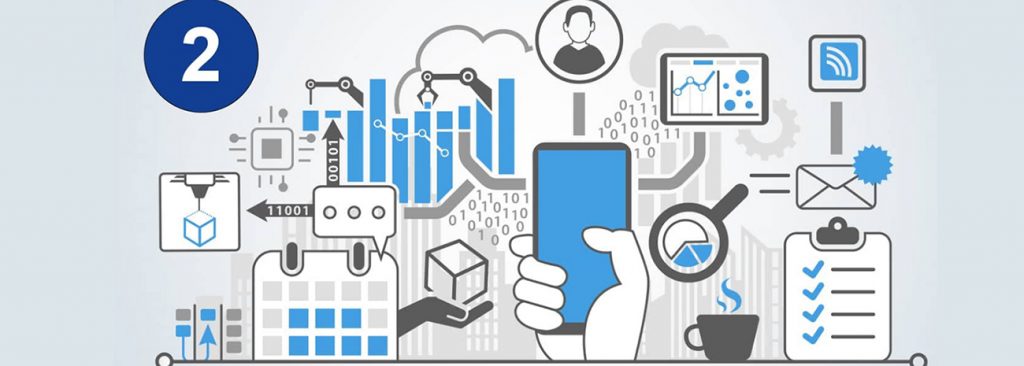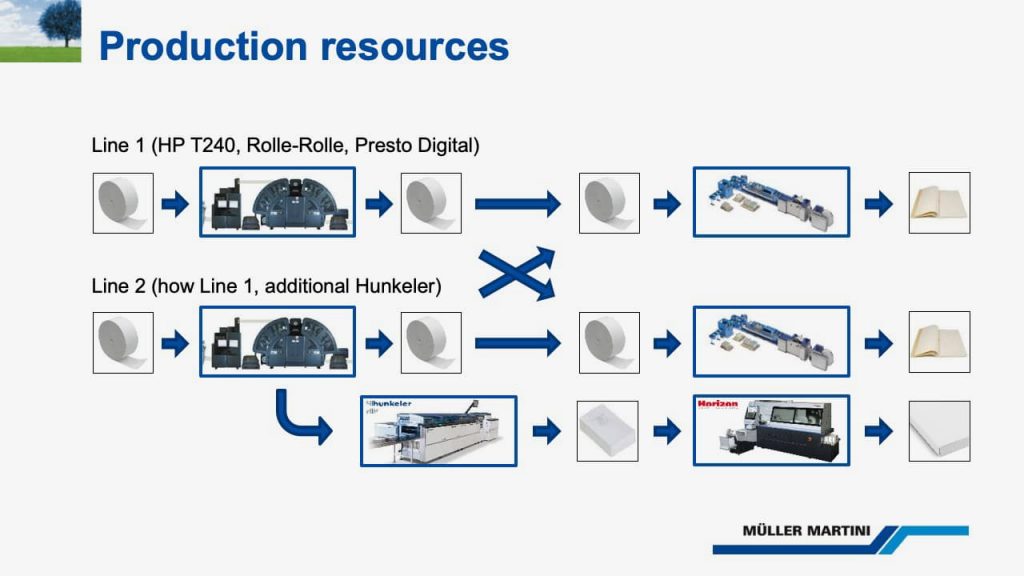
In the first blog of our four-part series on the topic of “Smart Factory” on 15 June 2021, I introduced you to a Muller Martini customer that has large-scale plants for (partially individualized) and fully networked volume production and fully integrates the different types of production. The second episode is now about a company that has largely networked and partially individualized short-run production with a cloud connection and has set itself the goal of efficient production without machine stops.
A production environment that organizes itself? Bookbinderies whose production processes are completely automated – from transport to in-house logistics to material flow? A digital book production system that produces 100 individualized book-of-ones almost as fast as 100 copies of a single title? And without human intervention in the production process?
The magic word to answer these questions, which until a good decade ago seemed almost utopian, is Smart Factory. In the wake of Industry 4.0, the Smart Factory is now a reality in the graphic arts industry. Only the networking of embedded production systems and dynamic business processes makes it possible to manufacture products profitably, even with individual customer requirements.
With its development strategy Finishing 4.0, which is based on Industry 4.0, Muller Martini is a leader in the implementation of networked production processes. Their biggest drivers are new business models. Keywords here are Variable Data Printing (VDP), personalized print products, photo books, Web2Print and Print-on-Demand.
The customer
This typical smart factory customer of Muller Martini presented in this blog has an extensively networked and partially individualized short-run production with cloud connection. It has set itself the goal of efficient production without machine stops.
Step 1: understand digitization
The cloud solution HP Site Flow used by the company needs an interface to Muller Martini’s Connex workflow system. The press delivers the necessary info (Which jobs are on the roll? Does it have waste?) for each roll to Connex. Connex prints out a material consignment note with information for the press operator so that he can react immediately in the event of problem messages (e.g. cover matching). This avoids faulty production.
Step 2: clarify company needs
On the one hand, the production forms are different for this customer, who produces soft covers and saddle stitching. On the other hand, the product range is very broad. However, since all products come from digital printing, there is no need for additional coordination between the two forms of printing.
Step 3: acquire process competence

If two identical digital presses (roll-to-roll) “feed” a Presto II Digital saddle stitcher and the second line also “feeds” (by means of a turner bar) a Hunkeler book block machine and a perfect binder from another supplier, and HP Site Flow is combined with Connex (controls prepress and press), a high level of process expertise is required.
This (nearline) solution with a high degree of automation brings the customer great advantages in several respects. The intelligent web manifest relieves the operator, who can also access a job preview with press feedback at any time. Jobs are loaded via barcode, which eliminates input errors. The workflow (imposition/JDF management/tracking) is fully automated. The optimal production allows for a very high performance of the machines.
Step 4: shape digital transformation
Thanks to the HP Site Flow/Connex interface solution, the customer has an end-to-end JDF management for prepress, press and postpress, digital sheet assembly for all modules, and individual product tracking as well as roll accompanying slips and roll management at all times. Job previews are based on feedback from the presses.
The top 5 benefits of this customer example and your advantages at a glance
- Benefit 1: The HP Site Flow cloud solution can be seamlessly connected to the Connex workflow system from Muller Martini. – Your advantage: You have a lean, secure and cost-efficient integration thanks to the use of proven and well-known IT interfaces.
- Benefit 2: The press delivers all relevant information to Connex for each roll. – Your advantage: Your press operator receives a printed material consignment note from Connex. This means that even rolls with problem areas can be processed reliably and without errors.
- Benefit 3: All orders on a roll are loaded via barcode. – Your advantage: Redundant data entries are eliminated, and thus there are also fewer sources of error. Your operators can concentrate fully on production.
- Benefit 4: The workflow (pre-press, job tickets and product tracking) is fully automated. – Your advantage: You have seamless re-use of existing job data and information. Prepress runs completely in the background, enabling efficient short runs without manual preparation steps.
- Benefit 5: Minimal manual intervention for press makeready enables very high overall machine performance. – Your advantage: Production resources can be optimally utilized and unproductive downtime can be avoided.
A valuable white paper to download
If you would like more in-depth information about the digital transformation and Muller Martini’s ideas on the Smart Factory, I recommend reading our detailed whitepaper on this topic. You can download it easily using the link below.
In the third installment of our blog series on 14 September 2021, get to know a company that has a Smart Factory with fully networked single-book and short-run production and aims to produce a wide variety of production types as well as intelligently dovetail the entire production cell across all lines using a uniform workflow.
Your
Georg Riva
VP Global Sales Muller Martini
This text is reproduced with kind permission of Müller Martini, you can read the original article first published here.
